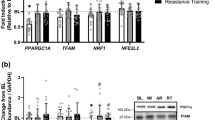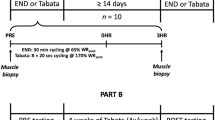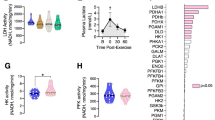Abstract
The aim of the present study was to examine the effects of ageing and training status on (1) markers of skeletal muscle mitochondrial content and (2) the ability to activate the acute signalling pathways associated with regulating exercise-induced mitochondrial biogenesis. Muscle biopsies were obtained from the vastus lateralis muscle of young untrained (24 ± 4 years, n = 6; YU), young trained (22 ± 3 years, n = 6; YT), old untrained (65 ± 6 years, n = 6; OU) and old trained (64 ± 3 years, n = 6; OT) healthy males before and after (3 h and 3 days post-exercise) completion of high-intensity interval cycling exercise. In resting muscle, lifelong training preserved mtDNA, PGC-1α and COXIV protein content such that muscles from OT individuals were comparable to muscles from both YU and YT individuals, whereas lifelong sedentary behaviour reduced such markers of mitochondrial content. Regardless of age or training status, acute exercise induced comparable increases in p38MAPK phosphorylation immediately post-exercise, PGC-1α and COXIV mRNA expression at 3 h post-exercise and COXIV protein at 3 days post-exercise. Data demonstrate that lifelong endurance training preserves skeletal muscle PGC-1α content and that despite the mitochondrial dysfunction typically observed with sedentary ageing, muscles from sedentary elderly individuals retain the capacity to activate the acute signalling pathways associated with regulating the early processes of mitochondrial biogenesis. We consider our data to have immediate translational potential as they highlight the potential therapeutic effects of exercise to induce skeletal muscle mitochondrial biogenesis persist late in adulthood, even after a lifetime of physical inactivity.



Similar content being viewed by others
References
Bartlett JD, Hwa Joo C, Jeong TS, Louhelainen J, Cochran AJ, Gibala MJ, Gregson W, Close GL, Drust B, Morton JP (2012) Matched work high-intensity interval and continuous running induce similar increases in PGC-1alpha mRNA, AMPK, p38, and p53 phosphorylation in human skeletal muscle. J Appl Physiol 112(7):1135–1143. doi:10.1152/japplphysiol.01040.2011
Benziane B, Burton TJ, Scanlan B, Galuska D, Canny BJ, Chibalin AV, Zierath JR, Stepto NK (2008) Divergent cell signaling after short-term intensified endurance training in human skeletal muscle. Am J Physiol Endocrinol Metab 295(6):E1427–E1438. doi:10.1152/ajpendo.90428.2008
Carter CS, Hofer T, Seo AY, Leeuwenburgh C (2007) Molecular mechanisms of life- and health-span extension: role of calorie restriction and exercise intervention. Appl Physiol Nutr Metab 32(5):954–966. doi:10.1139/H07-085
Close GL, Kayani A, Vasilaki A, McArdle A (2005) Skeletal muscle damage with exercise and aging. Sports Med 35(5):413–427
Derbre F, Gomez-Cabrera MC, Nascimento AL, Sanchis-Gomar F, Martinez-Bello VE, Tresguerres JA, Fuentes T, Gratas-Delamarche A, Monsalve M, Vina J (2012) Age associated low mitochondrial biogenesis may be explained by lack of response of PGC-1alpha to exercise training. Age (Dordr) 34(3):669–679. doi:10.1007/s11357-011-9264-y
Gianni P, Jan KJ, Douglas MJ, Stuart PM, Tarnopolsky MA (2004) Oxidative stress and the mitochondrial theory of aging in human skeletal muscle. Exp Gerontol 39(9):1391–1400. doi:10.1016/j.exger.2004.06.002
Iversen N, Krustrup P, Rasmussen HN, Rasmussen UF, Saltin B, Pilegaard H (2011) Mitochondrial biogenesis and angiogenesis in skeletal muscle of the elderly. Exp Gerontol 46(8):670–678. doi:10.1016/j.exger.2011.03.004
Janssen I, Shepard DS, Katzmarzyk PT, Roubenoff R (2004) The healthcare costs of sarcopenia in the United States. J Am Geriatr Soc 52(1):80–85
Joseph AM, Adhihetty PJ, Buford TW, Wohlgemuth SE, Lees HA, Nguyen LM, Aranda JM, Sandesara BD, Pahor M, Manini TM, Marzetti E, Leeuwenburgh C (2012) The impact of aging on mitochondrial function and biogenesis pathways in skeletal muscle of sedentary high- and low-functioning elderly individuals. Aging Cell. doi:10.1111/j.1474-9726.2012.00844.x
Kowald A, Kirkwood TB (1996) A network theory of ageing: the interactions of defective mitochondria, aberrant proteins, free radicals and scavengers in the ageing process. Mutat Res 316(5–6):209–236
Lanza IR, Short DK, Short KR, Raghavakaimal S, Basu R, Joyner MJ, McConnell JP, Nair KS (2008) Endurance exercise as a countermeasure for aging. Diabetes 57(11):2933–2942. doi:10.2337/db08-0349
Lezza AM, Boffoli D, Scacco S, Cantatore P, Gadaleta MN (1994) Correlation between mitochondrial DNA 4977-bp deletion and respiratory chain enzyme activities in aging human skeletal muscles. Biochem Biophys Res Commun 205(1):772–779. doi:10.1006/bbrc.1994.2732
Little JP, Safdar A, Wilkin GP, Tarnopolsky MA, Gibala MJ (2010) A practical model of low-volume high-intensity interval training induces mitochondrial biogenesis in human skeletal muscle: potential mechanisms. J Physiol 588(Pt 6):1011–1022. doi:10.1113/jphysiol.2009.181743
Ljubicic V, Hood DA (2009) Diminished contraction-induced intracellular signaling towards mitochondrial biogenesis in aged skeletal muscle. Aging Cell 8(4):394–404. doi:10.1111/j.1474-9726.2009.00483.x
Ljubicic V, Joseph AM, Adhihetty PJ, Huang JH, Saleem A, Uguccioni G, Hood DA (2009) Molecular basis for an attenuated mitochondrial adaptive plasticity in aged skeletal muscle. Aging (Albany NY) 1(9):818–830
Ljubicic V, Joseph AM, Saleem A, Uguccioni G, Collu-Marchese M, Lai RY, Nguyen LM, Hood DA (2010) Transcriptional and post-transcriptional regulation of mitochondrial biogenesis in skeletal muscle: effects of exercise and aging. Biochim Biophys Acta 1800(3):223–234. doi:10.1016/j.bbagen.2009.07.031
Mahoney DJ, Carey K, Fu MH, Snow R, Cameron-Smith D, Parise G, Tarnopolsky MA (2004) Real-time RT-PCR analysis of housekeeping genes in human skeletal muscle following acute exercise. Physiol Genomics 18(2):226–231. doi:10.1152/physiolgenomics.00067.2004
Mahoney DJ, Parise G, Melov S, Safdar A, Tarnopolsky MA (2005) Analysis of global mRNA expression in human skeletal muscle during recovery from endurance exercise. FASEB J 19(11):1498–1500. doi:10.1096/fj.04-3149fje
McArdle A, Dillmann WH, Mestril R, Faulkner JA, Jackson MJ (2004) Overexpression of HSP70 in mouse skeletal muscle protects against muscle damage and age-related muscle dysfunction. FASEB J 18(2):355–357. doi:10.1096/fj.03-0395fje
McKenzie D, Bua E, McKiernan S, Cao Z, Aiken JM (2002) Mitochondrial DNA deletion mutations: a causal role in sarcopenia. Eur J Biochem 269(8):2010–2015
Nordsborg NB, Lundby C, Leick L, Pilegaard H (2010) Relative workload determines exercise-induced increases in PGC-1alpha mRNA. Med Sci Sports Exerc 42(8):1477–1484. doi:10.1249/MSS.0b013e3181d2d21c
Perry CG, Lally J, Holloway GP, Heigenhauser GJ, Bonen A, Spriet LL (2010) Repeated transient mRNA bursts precede increases in transcriptional and mitochondrial proteins during training in human skeletal muscle. J Physiol 588(Pt 23):4795–4810. doi:10.1113/jphysiol.2010.199448
Rennie MJ, Selby A, Atherton P, Smith K, Kumar V, Glover EL, Philips SM (2010) Facts, noise and wishful thinking: muscle protein turnover in aging and human disuse atrophy. Scand J Med Sci Sports 20(1):5–9. doi:10.1111/j.1600-0838.2009.00967.x
Reznick RM, Zong H, Li J, Morino K, Moore IK, Yu HJ, Liu ZX, Dong J, Mustard KJ, Hawley SA, Befroy D, Pypaert M, Hardie DG, Young LH, Shulman GI (2007) Aging-associated reductions in AMP-activated protein kinase activity and mitochondrial biogenesis. Cell Metab 5(2):151–156. doi:10.1016/j.cmet.2007.01.008
Safdar A, Hamadeh MJ, Kaczor JJ, Raha S, Debeer J, Tarnopolsky MA (2010) Aberrant mitochondrial homeostasis in the skeletal muscle of sedentary older adults. PLoS ONE 5(5):e10778. doi:10.1371/journal.pone.0010778
Sandri M, Lin J, Handschin C, Yang W, Arany ZP, Lecker SH, Goldberg AL, Spiegelman BM (2006) PGC-1alpha protects skeletal muscle from atrophy by suppressing FoxO3 action and atrophy-specific gene transcription. Proc Natl Acad Sci USA 103(44):16260–16265. doi:10.1073/pnas.0607795103
Wenz T (2011) Mitochondria and PGC-1alpha in aging and age-associated diseases. J Aging Res 2011:810619. doi:10.4061/2011/810619
Wenz T, Rossi SG, Rotundo RL, Spiegelman BM, Moraes CT (2009) Increased muscle PGC-1alpha expression protects from sarcopenia and metabolic disease during aging. Proc Natl Acad Sci USA 106(48):20405–20410. doi:10.1073/pnas.0911570106
Wenz T, Williams SL, Bacman SR, Moraes CT (2010) Emerging therapeutic approaches to mitochondrial diseases. Dev Disabil Res Rev 16(2):219–229. doi:10.1002/ddrr.109
Acknowledgments
Age UK are thanked for providing financial support. We also acknowledge the efforts of all the subjects for their outstanding efforts during a demanding exercise protocol. Finally, we thank Rob Allan and Chang Haw-Joo for providing technical support during data collection.
Author information
Authors and Affiliations
Corresponding author
Rights and permissions
About this article
Cite this article
Cobley, J.N., Bartlett, J.D., Kayani, A. et al. PGC-1α transcriptional response and mitochondrial adaptation to acute exercise is maintained in skeletal muscle of sedentary elderly males. Biogerontology 13, 621–631 (2012). https://doi.org/10.1007/s10522-012-9408-1
Received:
Accepted:
Published:
Issue Date:
DOI: https://doi.org/10.1007/s10522-012-9408-1




